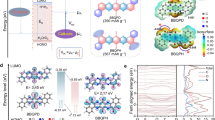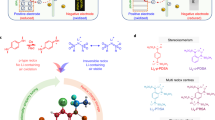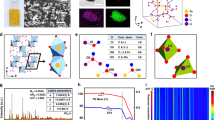Abstract
Even though organic molecules with well-designed functional groups can be programmed to have high electron density per unit mass, their poor electrical conductivity and low cycle stability limit their applications in batteries. Here we report a facile synthesis of π-conjugated quinoxaline-based heteroaromatic molecules (3Q) by condensation of cyclic carbonyl molecules with o-phenylenediamine. 3Q features a number of electron-deficient pyrazine sites, where multiple redox reactions take place. When hybridized with graphene and coupled with an ether-based electrolyte, an organic cathode based on 3Q molecules displays a discharge capacity of 395 mAh g−1 at 400 mA g−1 (1C) in the voltage range of 1.2–3.9 V and a nearly 70% capacity retention after 10,000 cycles at 8 A g−1. It also exhibits a capacity of 222 mAh g−1 at 20C, which corresponds to 60% of the initial specific capacity. Our results offer evidence that heteroaromatic molecules with multiple redox sites are promising in developing high-energy-density, long-cycle-life organic rechargeable batteries.
This is a preview of subscription content, access via your institution
Access options
Access Nature and 54 other Nature Portfolio journals
Get Nature+, our best-value online-access subscription
$29.99 / 30 days
cancel any time
Subscribe to this journal
Receive 12 digital issues and online access to articles
$119.00 per year
only $9.92 per issue
Buy this article
- Purchase on Springer Link
- Instant access to full article PDF
Prices may be subject to local taxes which are calculated during checkout





Similar content being viewed by others
References
Larcher, D. & Tarascon, J.-M. Towards greener and more sustainable batteries for electrical energy storage. Nat. Chem. 7, 19–29 (2015).
Armand, M. et al. Conjugated dicarboxylate anodes for Li-ion batteries. Nat. Mater. 8, 120–125 (2009).
Morita, Y. et al. Organic tailored batteries materials using stable open-shell molecules with degenerate frontier orbitals. Nat. Mater. 10, 947–951 (2011).
Nokami, T. et al. Polymer-bound pyrene-4, 5, 9, 10-tetraone for fast-charge and -discharge lithium-ion batteries with high capacity. J. Am. Chem. Soc. 134, 19694–19700 (2012).
Hong, J. et al. Biologically inspired pteridine redox centres for rechargeable batteries. Nat. Commun. 5, 5335 (2014).
Song, Z., Zhan, H. & Zhou, Y. Polyimides: promising energy-storage materials. Angew. Chem. Int. Ed. 49, 8444–8448 (2010).
Huang, W. et al. Quasi-solid-state rechargeable lithium-ion batteries with a calix[4]quinone cathode and gel polymer electrolyte. Angew. Chem. Int. Ed. 52, 9162–9166 (2013).
Zhu, Z. et al. All-solid-state lithium organic battery with composite polymer electrolyte and pillar[5]quinone cathode. J. Am. Chem. Soc. 136, 16461–16464 (2014).
Deng, W. et al. A low cost, all-organic Na-ion battery based on polymeric cathode and anode. Sci. Rep. 3, 2671 (2013).
Zhao, L. et al. Disodium terephthalate (Na2C8H4O4) as high performance anode material for low-cost room-temperature sodium-ion battery. Adv. Energy Mater. 2, 962–965 (2012).
Kim, Y. J., Wu, W., Chun, S.-E., Whitacre, J. F. & Bettinger, C. J. Catechol-mediated reversible binding of multivalent cations in eumelanin half-cells. Adv. Mater. 26, 6572–6579 (2014).
Reed, L. D., Ortiz, S. N., Xiong, M. & Menke, E. J. A rechargeable aluminum-ion battery utilizing a copper hexacyanoferrate cathode in an organic electrolyte. Chem. Commun. 51, 14397–14400 (2015).
Häupler, B. et al. Aqueous zinc-organic polymer battery with a high rate performance and long lifetime. NPG Asia Mater. 8, e283 (2016).
Gan, S., Zhong, L., Gao, L., Han, D. & Niu, L. Electrochemically driven surface-confined acid/base reaction for an ultrafast H+ supercapacitor. J. Am. Chem. Soc. 138, 1490–1493 (2016).
Vlad, A., Singh, N., Rolland, J., Melinte, S., Ajayan, P. M. & Gohy, J.-F. Hybrid supercapacitor-battery materials for fast electrochemical charge storage. Sci. Rep. 4, 4315 (2014).
Suga, T., Konishi, H. & Nishide, H. Photocrosslinked nitroxide polymer cathode-active materials for application in an organic-based paper battery. Chem. Commun. 2007, 1730–1732 (2007).
Choi, W., Harada, D., Oyaizu, K. & Nishide, H. Aqueous electrochemistry of poly(vinylanthraquinone) for anode-active materials in high-density and rechargeable polymer/air batteries. J. Am. Chem. Soc. 133, 19839–19843 (2011).
Qin, H., Song, Z. P., Zhan, H. & Zhou, Y. H. Aqueous rechargeable alkali-ion batteries with polyimide anode. J. Power Sources 249, 367–372 (2014).
Huskinson, B. et al. A metal-free organic–inorganic aqueous flow battery. Nature 505, 195–198 (2014).
Janoschka, T. et al. An aqueous, polymer-based redox-flow battery using non-corrosive, safe, and low-cost materials. Nature 527, 78–81 (2015).
Lin, K. et al. Alkaline quinone flow battery. Science 349, 1529–1532 (2015).
Wei, X. et al. TEMPO-based catholyte for high-energy density nonaqueous redox flow batteries. Adv. Mater. 26, 7649–7653 (2014).
Milczarek, G. & Inganäs, O. Renewable cathode materials from biopolymer/conjugated polymer interpenetrating networks. Science 335, 1468–1471 (2012).
Novák, P., Müller, K., Santhanam, K. S. V. & Haas, O. Electrochemically active polymers for rechargeable batteries. Chem. Rev. 97, 207–282 (1997).
Oyama, N., Tatsuma, T., Sato, T. & Sotomura, T. Dimercaptan–polyaniline composite electrodes for lithium batteries with high energy density. Nature 373, 598–600 (1995).
Chung, W. et al. The use of elemental sulfur as an alternative feedstock for polymeric materials. Nat. Chem. 5, 518–524 (2013).
Wang, J., Yang, J., Xie, J. & Xu, N. A novel conductive polymer–sulfur composite cathode material for rechargeable lithium batteries. Adv. Mater. 14, 963–965 (2002).
Guo, W., Yin, Y.-X., Xin, S., Guo, Y.-G. & Wan, L.-J. Superior radical polymer cathode material with a two-electron process redox reaction promoted by graphene. Energy Environ. Sci. 5, 5221–5225 (2012).
Janoschka, T. et al. Reactive inkjet printing of cathodes for organic radical batteries. Adv. Energy Mater. 3, 1025–1028 (2013).
Walker, W. et al. Ethoxycarbonyl-based organic electrode for Li-batteries. J. Am. Chem. Soc. 132, 6517–6523 (2010).
Han, X., Chang, C., Yuan, L., Sun, T. & Sun, J. Aromatic carbonyl derivative polymers as high-performance Li-ion storage materials. Adv. Mater. 19, 1616–1621 (2007).
Chen, D. et al. A rigid naphthalenediimide triangle for organic rechargeable lithium-ion batteries. Adv. Mater. 27, 2907–2912 (2015).
Chen, H. et al. Lithium salt of tetrahydroxybenzoquinone: toward the development of a sustainable Li-ion battery. J. Am. Chem. Soc. 131, 8984–8988 (2009).
Jaffe, A., Valdes, A. S. & Karunadasa, H. I. Quinone-functionalized carbon black cathodes for lithium batteries with high power densities. Chem. Mater. 27, 3568–3571 (2015).
Liang, Y., Zhang, P., Yang, S., Tao, Z. & Chen, J. Fused heteroaromatic organic compounds for high-power electrodes of rechargeable lithium batteries. Adv. Energy Mater. 3, 600–605 (2013).
Castillo-Martínez, E., Carretero-González, J. & Armand, M. Polymeric Schiff bases as low-voltage redox centers for sodium-ion batteries. Angew. Chem. Int. Ed. 53, 5341–5345 (2014).
Yao, M. et al. Indigo carmine: an organic crystal as a positive-electrode material for rechargeable sodium batteries. Sci. Rep. 4, 3650 (2013).
Chen, R., Luo, R., Huang, Y., Wu, F. & Li, L. Advanced high energy density secondary batteries with multi-electron reaction materials. Adv. Sci. 3, 1600051 (2016).
Wu, X. et al. Unraveling the storage mechanism in organic carbonyl electrodes for sodium-ion batteries. Sci. Adv. 1, e1500330 (2015).
Skujins, S., Delderfield, J. & Webb, G. A. Spectroscopic and structural studies of some oxocarbon condensation products—II: a mass spectrometric study of some substituted phenazines and quinoxalines. Tetrahedron 25, 3947–3954 (1969).
Burgstahler, A. W. & Barkhurst, R. C. Preparation of leuconic acid from inositol. Trans. Kansas Acad. Sci. 71, 150–153 (1968).
Stephens, P. J., Devlin, F. J., Chabalowski, C. F. & Frisch, M. J. Ab initio calculation of vibrational absorption and circular dichroism spectra using density functional force fields. J. Phys. Chem. 98, 11623–11627 (1994).
Becke, A. D. Density-functional thermochemistry. III. The role of exact exchange. J. Chem. Phys. 98, 5648–5652 (1993).
Frisch, M. J. et al. Gaussian 09, Revision A (Gaussian, 2009).
Hehre, W. J., Ditchfie, R. & Pople, J. A. Self-consistent molecular-orbital methods. XII. Further extensions of gaussian-type basis sets for use in molecular-orbital studies of organic-molecules. J. Chem. Phys. 56, 2257–2261 (1972).
Dill, J. D. & Pople, J. A. Self-consistent molecular-orbital methods. XV. Extended gaussian-type basis sets for lithium, beryllium, and boron. J. Chem. Phys. 62, 2921–2923 (1975).
Francl, M. M. et al. Self-consistent molecular-orbital methods. XXIII. A polarization-type basis set for second-row elements. J. Chem. Phys. 77, 3654–3665 (1982).
Miertuš, S., Scrocco, E. & Tomasi, J. Electrostatic interaction of a solute with a continuum. A direct utilization of ab initio molecular potentials for the prevision of solvent effects. Chem. Phys. 55, 117–129 (1981).
Zhou, M. et al. High-performance silicon battery anodes enabled by engineering graphene assemblies. Nano Lett. 15, 6222–6228 (2015).
Chung, K. Y., Yoon, W., Kim, K., Cho, B.-W. & Yang, X.-Q. Formation of an SEI on a LiMn2O4 cathode during room temperature charge–discharge cycling studied by soft X-ray absorption spectroscopy at the fluorine K-edge. J. Appl. Electrochem. 41, 1295–1299 (2011).
Tasaki, K., Goldberg, A., Lian, J.-J., Walker, M., Timmons, A. & Harris, S. J. Solubility of lithium salts formed on the lithium-ion battery negative electrode surface in organic solvents. J. Electrochem. Soc. 156, A1019–A1027 (2009).
Aurbach, D., Weissman, I. & Schechter, A. X-ray photoelectron spectroscoscopy studies of lithium surface prepared in several important electrolyte solution. A comparison with previous studies by Fourier transform infrared spectroscopy. Langmuir 12, 3991–4007 (1996).
Li, W., Yao, H., Yan, K., Zheng, G., Liang, Z., Chiang, Y.-M. & Cui, Y. The synergetic effect of lithium polysulfide and lithium nitrate to prevent lithium dendrite growth. Nat. Commun. 6, 7436 (2015).
Schechter, A. & Aurbach, D. X-ray photoelectron spectroscoscopy study of surface films formd on Li electrodes freshly prepared in alkyl carbonate solutions. Langmuir 15, 3334–3342 (1999).
Aurbach, D. et al. On the surface chemical aspects of very high energy density, rechargeable Li–sulfur batteries. J. Electrochem. Soc. 156, A694 (2009).
Suo, L., Hu, Y.-S., Li, H., Armand, M. & Chen, L. A new class of solvent-in-salt electrolyte for high-energy rechargeable metallic lithium batteries. Nat. Commun. 4, 1481 (2013).
Cheng, X.-B. et al. A review of solid electrolyte interphases on lithium metal anode. Adv. Sci. 3, 1500213 (2016).
Acknowledgements
This work was supported by the National Research Foundation Investigator Award (NRF-NRF12015-01) ‘Graphene oxide – A new class of catalytic, ionic and molecular sieving materials’ funded by National Research Foundation, Prime Minister’s Office, Singapore. Y.Y. would like to acknowledge the financial support for their research at Xiamen University from National Natural Science Foundation of China (Grant Nos 21233004 and 21621091) and National Key Research and Development Program (Grant No. 2016YFB0901502).
Author information
Authors and Affiliations
Contributions
C.P., J.S., C.S., Y.-S.H., Y.Y. and K.P.L. conceived and designed this work. J.S., C.P., G.-H.N. and D.Y. performed the syntheses and characterization of 2Q and 3Q materials, including 15N-labelled 3Q samples. G.-H.N. and B.T. prepared and characterized single-crystalline 3Q. C.P. and G.-H.N. conducted the EPR characterization. J.S. and C.P. assembled the cells for 2Q and 3Q and conducted the measurements. C.P. and G.Z. assembled the pouch cells for 15N-labelled 3Q and characterized the resource for 15N- and 13C-labelled 3Q during the charging/discharging processes. C.P., G.Z., Y.-S.H., M.-F.N., J.Y., M.A., Y.Y. and K.L. analysed the solid-state NMR results and proposed the mechanism. M.-F.N. conducted the DFT simulation. W.T. and J.S. performed TEM for 3Q samples after cycling. C.P. acquired high-resolution SRPES data. C.P., G.-H.N., L.Z., M.-F.N., J.Y., Y.-S.H., Y.Y., M.A. and K.P.L. co-wrote the manuscript. All the authors discussed the results and commented on the manuscript at all stages.
Corresponding authors
Ethics declarations
Competing interests
The authors declare no competing financial interests.
Supplementary information
Supplementary Information
Supplementary Figures 1–36, Supplementary Tables 16, Supplementary Notes (PDF 2982 kb)
Rights and permissions
About this article
Cite this article
Peng, C., Ning, GH., Su, J. et al. Reversible multi-electron redox chemistry of π-conjugated N-containing heteroaromatic molecule-based organic cathodes. Nat Energy 2, 17074 (2017). https://doi.org/10.1038/nenergy.2017.74
Received:
Accepted:
Published:
DOI: https://doi.org/10.1038/nenergy.2017.74
This article is cited by
-
The homogenous growth of Co-based coordination compound on graphene nanosheet for high-performance K-organic battery and its reaction mechanism
Rare Metals (2024)
-
Structural Isomers: Small Change with Big Difference in Anion Storage
Nano-Micro Letters (2024)
-
Hydrothermal synthesis of polyimide-linked covalent organic frameworks towards ultrafast and stable cathodic sodium storage
Science China Chemistry (2024)
-
Tuning electron delocalization of hydrogen-bonded organic framework cathode for high-performance zinc-organic batteries
Nature Communications (2023)
-
Small-molecule organic electrode materials for rechargeable batteries
Science China Chemistry (2023)



